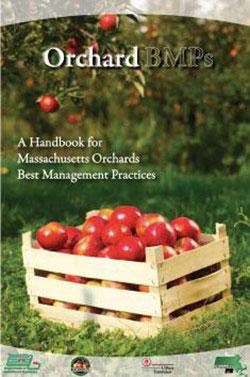Orchard BMP Manual
 The activities covered in this guide range from soil management through pesticide application. The New England Tree Fruit Management Guide forms the primary background material detailing the many possible choices which can be classified as BMPs during the crop production phase. The BMP checklist provides some evaluation of where choices fall within the spectrum of best management practices, but please realize that this is a value judgment. It is important to note that the checklist does not include all possible activities in an orchard and is not intended to say that one orchard is a “BMP orchard” and another is not. For more detail regarding choices presented in the checklist, please refer to the New England Fruit Management Guide section of this handbook.
The activities covered in this guide range from soil management through pesticide application. The New England Tree Fruit Management Guide forms the primary background material detailing the many possible choices which can be classified as BMPs during the crop production phase. The BMP checklist provides some evaluation of where choices fall within the spectrum of best management practices, but please realize that this is a value judgment. It is important to note that the checklist does not include all possible activities in an orchard and is not intended to say that one orchard is a “BMP orchard” and another is not. For more detail regarding choices presented in the checklist, please refer to the New England Fruit Management Guide section of this handbook.
Good agricultural practices (GAPs) are a subset of BMPs which deal primarily with food safety. We chose to adopt the GAPs detailed by the National GAPs Program led by Cornell University. Their publication, 'Food Safety Begins on the Farm,' provides an excellent checklist of GAPs and background information about the choices available. This publication is included in its entirety in this handbook. It is very important to be in contact with fruit buyers regarding GAPs, and it is certain that some farmers may find it necessary to become GAPs certified. Certification training sessions are being provided by a few private companies, and likely will be conducted by the Commonwealth of Massachusetts in the near future.
It is important to note that this guide is the product of a significant cooperative effort. First, the producers of the two manual (New England Tree Fruit Management Guide and Food Safety Begins on the Farm) included in the guide deserve credit for excellent work. The final BMP Handbook resulted from a cooperative effort among the University of Massachusetts, the Massachusetts Farm Bureau Federation, and a group of tree‐fruit growers (Glenn Cook, Alex Dowse, Ken Nicewicz, Mo Tougas, and Steve Ware), with funding from the Massachusetts Department of Agricultural Resources.
We encourage all tree‐fruit growers to study this handbook and strive to utilize the best possible BMPs for your farm and to adopt GAPs at the highest level. In the long run, the future of Massachusetts farming will be enhanced by utilizing the most environmentally, economically profitable, and safest farming operations possible.
Table of Contents
 Massachusetts Tree-fruit Production Best Management Practices Checklist
Massachusetts Tree-fruit Production Best Management Practices Checklist
- Management Considerations for Sites with High Leaching or Runoff Potential
- Additional Preplant Considerations
- Site and Soil Considerations for Established Orchard Blocks
- Nutrient Management for Established Orchard Blocks
- Plant Culture and Irrigation Practices
- Pesticide Handling
- Pest Control Practices
- Plant Growth Regulators
- On‐farm Energy Conservation and Production
New England Tree Fruit Management Guide
- Integrated Crop and Pest Management
- Organic Tree Fruit Production in New England
- Pesticide Information
- Sprayer Information
- Characteristics of Crop Protectants Used on Tree Fruits
- Disease Management
- Insect and Mite Management
- Weed Management
- Wildlife Management
- Nutrient Management of Apple Orchards
- General Pest Management Considerations – Apples
- General Pest Management Considerations – Pears
- General Pest Management Considerations – Cherries
- General Pest Management Considerations – Peaches and Nectarines
- General Pest Management Considerations – Apricots
- General Pest Management Considerations – Plums and Prunes
- Weed Control Guidelines
- Appendices
National GAPs Educational Material—Food Safety Begins on the Farm
- Good Agricultural Practices
- Introduction
- Instructions
- My Farm Assessment
- Glossary of Terms
- Record Keeping
- Worker Hygiene
- Toilets and Handwashing
- Water Use
- Pesticide Use
- Manure Use
- Compost Use
- Heard Health
- Wild Animals
- Harvest Sanitation
- Postharvest Handling
- Juice and Cider
- Direct Marketing
- U‐Pick Operations
- Petting Zoos
- Farm Biosecurity
- Crisis Management
- References